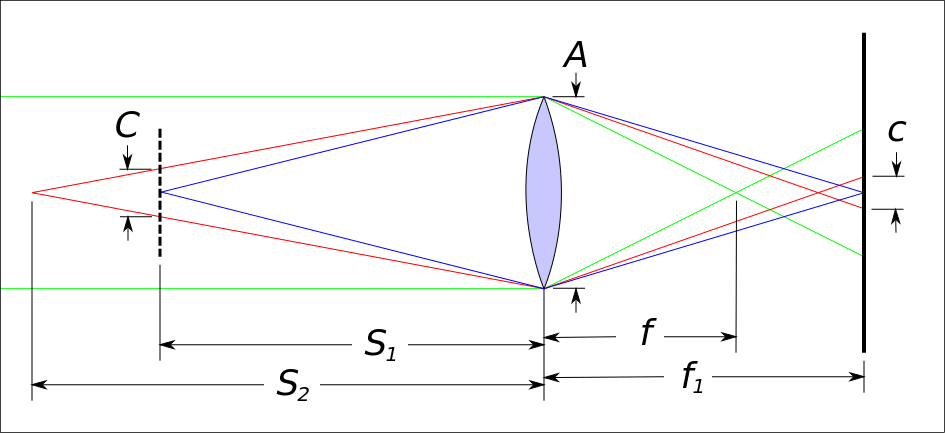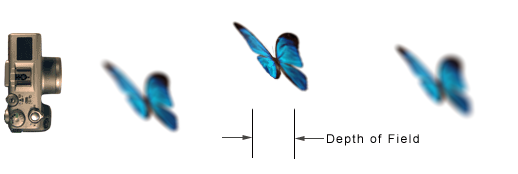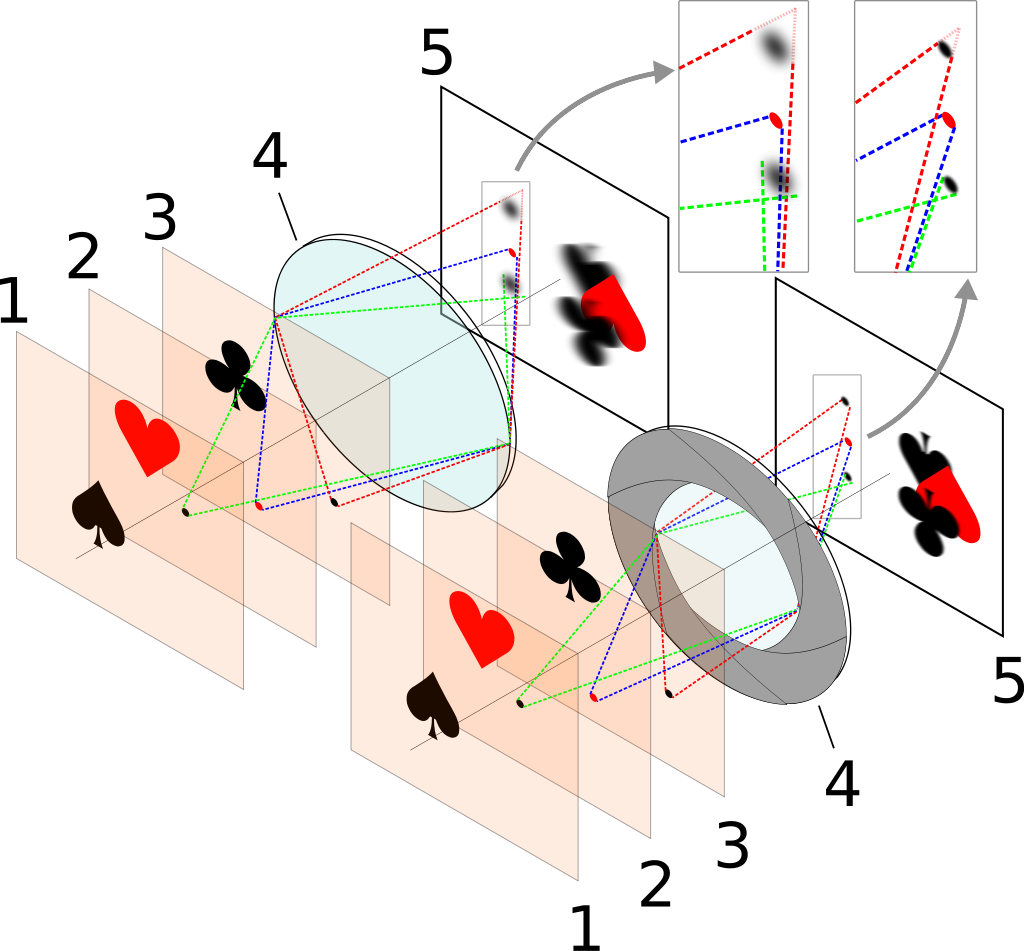為什麼一張圖

一個式子
![]()
![]()
這裡 ![]() 。
。
會令人如此困惑耶?假使不知道它說人眼『分辨率』有極限!藉此來定義『模糊』與『清晰』的分野。即使不談『孔徑』,一個透鏡也自有邊界 ![]() 的哩!更由於『成像條件』使得只有一物距
的哩!更由於『成像條件』使得只有一物距 ![]() 能完美聚焦成像
能完美聚焦成像 ![]() 【像距】。就此而論其它
【像距】。就此而論其它 ![]() 遠、近之物在像面上將形成『彌散圓』,要是它小到人可將之視為『點』,此時視力不得不以為成像『清晰』的了。雖然那個式子貌似複雜,涉及多個參數,其中
遠、近之物在像面上將形成『彌散圓』,要是它小到人可將之視為『點』,此時視力不得不以為成像『清晰』的了。雖然那個式子貌似複雜,涉及多個參數,其中 ![]() 與
與 ![]() 是這個光學系統內稟參數,實際是以『聚焦之物』
是這個光學系統內稟參數,實際是以『聚焦之物』 ![]() ,論述『相對』它物
,論述『相對』它物 ![]() 所產生的『模糊圈』大小而已。在下面兩種情況裡,
所產生的『模糊圈』大小而已。在下面兩種情況裡, ![]() 得以簡化︰
得以簡化︰
【聚焦於無窮遠】 ![]()
![]() ,與
,與 ![]() 無關。
無關。
【相對無窮遠之物】 ![]()
![]() ,與
,與 ![]() 無關。
無關。
或可先思其蘊涵意義耶!!
Circle of confusion diameter limit in photography
In photography, the circle of confusion diameter limit (“CoC”) for the final image is often defined as the largest blur spot that will still be perceived by the human eye as a point.
With this definition, the CoC in the original image (the image on the film or electronic sensor) depends on three factors:
- Visual acuity. For most people, the closest comfortable viewing distance, termed the near distance for distinct vision (Ray 2000, 52), is approximately 25 cm. At this distance, a person with good vision can usually distinguish an image resolution of 5 line pairs per millimeter (lp/mm), equivalent to a CoC of 0.2 mm in the final image.
- Viewing conditions. If the final image is viewed at approximately 25 cm, a final-image CoC of 0.2 mm often is appropriate. A comfortable viewing distance is also one at which the angle of view is approximately 60° (Ray 2000, 52); at a distance of 25 cm, this corresponds to about 30 cm, approximately the diagonal of an 8″×10″ image. It often may be reasonable to assume that, for whole-image viewing, a final image larger than 8″×10″ will be viewed at a distance correspondingly greater than 25 cm, and for which a larger CoC may be acceptable; the original-image CoC is then the same as that determined from the standard final-image size and viewing distance. But if the larger final image will be viewed at the normal distance of 25 cm, a smaller original-image CoC will be needed to provide acceptable sharpness.
- Enlargement from the original image to the final image. If there is no enlargement (e.g., a contact print of an 8×10 original image), the CoC for the original image is the same as that in the final image. But if, for example, the long dimension of a 35 mm original image is enlarged to 25 cm (10 inches), the enlargement is approximately 7×, and the CoC for the original image is 0.2 mm / 7, or 0.029 mm.
The common values for CoC may not be applicable if reproduction or viewing conditions differ significantly from those assumed in determining those values. If the original image will be given greater enlargement, or viewed at a closer distance, then a smaller CoC will be required. All three factors above are accommodated with this formula:
- CoC (mm) = viewing distance (cm) / desired final-image resolution (lp/mm) for a 25 cm viewing distance / enlargement / 25
For example, to support a final-image resolution equivalent to 5 lp/mm for a 25 cm viewing distance when the anticipated viewing distance is 50 cm and the anticipated enlargement is 8:
- CoC = 50 / 5 / 8 / 25 = 0.05 mm
Since the final-image size is not usually known at the time of taking a photograph, it is common to assume a standard size such as 25 cm width, along with a conventional final-image CoC of 0.2 mm, which is 1/1250 of the image width. Conventions in terms of the diagonal measure are also commonly used. The DoF computed using these conventions will need to be adjusted if the original image is cropped before enlarging to the final image size, or if the size and viewing assumptions are altered.
Using the “Zeiss formula”, the circle of confusion is sometimes calculated as d/1730 where d is the diagonal measure of the original image (the camera format). For full-frame 35 mm format (24 mm × 36 mm, 43 mm diagonal) this comes out to be 0.025 mm. A more widely used CoC is d/1500, or 0.029 mm for full-frame 35 mm format, which corresponds to resolving 5 lines per millimeter on a print of 30 cm diagonal. Values of 0.030 mm and 0.033 mm are also common for full-frame 35 mm format. For practical purposes, d/1730, a final-image CoC of 0.2 mm, and d/1500 give very similar results.
Criteria relating CoC to the lens focal length have also been used. Kodak (1972), 5) recommended 2 minutes of arc (the Snellen criterion of 30 cycles/degree for normal vision) for critical viewing, giving CoC ≈ f /1720, where f is the lens focal length. For a 50 mm lens on full-frame 35 mm format, this gave CoC ≈ 0.0291 mm. This criterion evidently assumed that a final image would be viewed at “perspective-correct” distance (i.e., the angle of view would be the same as that of the original image):
- Viewing distance = focal length of taking lens × enlargement
However, images seldom are viewed at the “correct” distance; the viewer usually doesn’t know the focal length of the taking lens, and the “correct” distance may be uncomfortably short or long. Consequently, criteria based on lens focal length have generally given way to criteria (such as d/1500) related to the camera format.
If an image is viewed on a low-resolution display medium such as a computer monitor, the detectability of blur will be limited by the display medium rather than by human vision. For example, the optical blur will be more difficult to detect in an 8″×10″ image displayed on a computer monitor than in an 8″×10″ print of the same original image viewed at the same distance. If the image is to be viewed only on a low-resolution device, a larger CoC may be appropriate; however, if the image may also be viewed in a high-resolution medium such as a print, the criteria discussed above will govern.
Depth of field formulas derived from geometrical optics imply that any arbitrary DoF can be achieved by using a sufficiently small CoC. Because of diffraction, however, this isn’t quite true. Using a smaller CoC requires increasing the lens f-number to achieve the same DOF, and if the lens is stopped down sufficiently far, the reduction in defocus blur is offset by the increased blur from diffraction. See the Depth of field article for a more detailed discussion.
也可細想針孔成像之幾何光學原理果然太完美矣??
每個『點光 源』球狀各向發射光芒,獨有與『針孔』『成一線』者 ,方得入此間,因此光量小,故需『暗箱』護,否則難賭物,只因背景光線強 。為何那『針孔』和『像面』之距離稱『焦距』?雖說『成一線』,實乃一『光錐』,匯聚在此處,術語不虛生,因襲稱『焦距』。有人還說『針孔相機』景深無限,深得廣漠無窮三昧︰

景深(英語:Depth of field, DOF)景深是指相機對焦點前後相對清晰的成像範圍。在光學中,尤其是錄影或是攝影,是一個描述在空間中,可以清楚成像的距離範圍。雖然透鏡只能夠將光聚到某一固定的距離,遠離此點則會逐漸模糊,但是在某一段特定的距離內,影像模糊的程度是肉眼無法察覺的,這段距離稱之為景深。當焦點設在超焦距處時,景深會從超焦距的一半延伸到無限遠,對一個固定的光圈值來說,這是最大的景深。
景深通常由物距、鏡頭焦距,以及鏡頭的光圈值所決定(相對於焦距的光圈大小)。除了在近距離時,一般來說景深是由物體的放大率以及透鏡的光圈值決定。固定光圈值時,增加放大率,不論是更靠近拍攝物或是使用長焦距的鏡頭,都會減少景深的距離;減少放大率時,則會增加景深。如果固定放大率時,增加光圈值(縮小光圈)則會增加景深;減小光圈值(增大光圈)則會減少景深。
對於某些影像,例如風景照,比較適合用較大的景深,然而在人像攝影時,則經常使用小景深來構圖,造成所謂背景虛化的效果。因為數位影像的進步,影像的銳利度可以由電腦後製而改變,因此也可以由後製的方式來改變景深。
─── 摘自《光的世界︰幾何光學二》
如是能得 ![]() 之意義乎??!!
之意義乎??!!

光圈對景深以及模糊圈的影響。焦點 (2) 可以在像平面 (5)成像,但是在不同距離的點,如 (1 跟 3)則會投影出一個模糊的點,此點已大於模糊圈。減少光圈的大小 (4) 可以減小那些不在焦點上的點的模糊圈大小,因此模糊就變的比較不易察覺,看起來這些點就變成都在景深內
Depth of field
In optics, particularly as it relates to film and photography, depth of field (DOF), also called focus range or effective focus range, is the distance between the nearest and farthest objects in a scene that appear acceptably sharp in an image. Although a lens can precisely focus at only one distance at a time, the decrease in sharpness is gradual on each side of the focused distance, so that within the DOF, the unsharpness is imperceptible under normal viewing conditions.
In some cases, it may be desirable to have the entire image sharp, and a large DOF is appropriate. In other cases, a small DOF may be more effective, emphasizing the subject while de-emphasizing the foreground and background. In cinematography, a large DOF is often called deep focus, and a small DOF is often called shallow focus.

The area within the depth of field appears sharp, while the areas beyond the depth of field appear blurry.
Circle of confusion criterion for depth of field
Precise focus is possible at only one distance; at that distance, a point object will produce a point image.[1] At any other distance, a point object is defocused, and will produce a blur spot shaped like the aperture, which for the purpose of analysis is usually assumed to be circular. When this circular spot is sufficiently small, it is indistinguishable from a point, and appears to be in focus; it is rendered as “acceptably sharp”. The diameter of the circle increases with distance from the point of focus; the largest circle that is indistinguishable from a point is known as the acceptable circle of confusion, or informally, simply as the circle of confusion. The acceptable circle of confusion is influenced by visual acuity, viewing conditions, and the amount by which the image is enlarged (Ray 2000, 52–53). The increase of the circle diameter with defocus is gradual, so the limits of depth of field are not hard boundaries between sharp and unsharp.